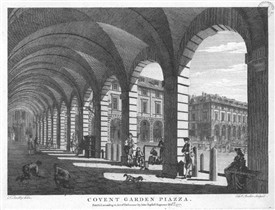Early Development

London At Five In The Morning
Covent Garden Community Assocation

Braun and Hogenberg map of London in Credit Braun & Hogenberg
Covent Garden Community Assocation

Covent Garden Piazza 1777
Westminster City Archives

Market and coffee houses dominate the Piazza Augustus Pugin and Thomas Rowlandson 1811
Westminster City Archives

Scene of Covent Garden market drawn F Nash engraved C Allen 1824
Westminster City Archives

Piazza by Sutton Nicholls c1720
Westminster City Archives
North of Long Acre, a central band of Covent Garden came into the hands of the Mercers Company by 1530, and they still own much of it today. Joan Bradbury, the wealthy widow of a Mercer and Lord Mayor of London, had built up a valuable estate. She bequeathed 150 acres of what is now London’s West End. But, in Henry VIII’s land-grab a decade later, various deals were forced upon the Mercers, leaving them only her property in Covent Garden: one 10 acre field. Aristocratic leaseholders built it up, and by 1650 there were 300 houses.
To the north west, a village and land belonged to the Leper Hospital founded by Queen Matilda in 1101 - including a chapel on the site of today’s St. Giles Church. This, too, was part of Henry VIII’s dissolution, and the hospital’s lands were surrendered to the Crown in 1539.
The rest of what is now Covent Garden comprised fields and clusters of property belonging to inns and various estates.
‘Cock and Pye’ fields stood between the Mercers’ lands and St. Giles. It remained sparsely developed until the entrepreneur and politician, Thomas Neale, acquired freeholds to portions of the land in 1690. He managed an extensive development along seven radiating streets, with a Doric column at the centre. The plots were sold in small groups to speculative builders and ‘Seven Dials’ was largely finished by 1695. It is the only quarter of London remaining from late Stuart England today.
Thomas Neale built more than was permitted by his building licence as granted by Sir Christopher Wren, then Surveyor General. And money for the project ran out before he could build the new church that was part of his obligations. Some less than scrupulous property developers have adopted a similar approach throughout the ages.
The new residents of Seven Dials to the north were not as refined as those on Lord Bedford’s Piazza estate to the south, and the dwellings were smaller, but the area was a respectable mix of merchants, the professional classes and successful tradesmen. However, Covent Garden did not remain respectable for long.
The Great Fire wiped out many of London’s markets in 1666, stopping halfway up Fleet Street. This brought more trade to the market in Covent Garden. In 1670 the Earl of Bedford secured a royal charter to make its activity official, from which time his estate was able to levy tolls on traders. The market became increasingly ‘wholesale’, and soon growers from outside London were cramming their carts into its streets every day.